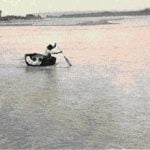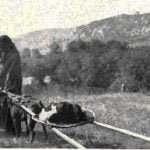
Before the introduction of the horse, the Plains Indians traveled on foot. The tribes living along the Mississippi made some use of canoes, according to early accounts, while those of the Missouri and inland, used only crude tub-like affairs for ferry purpose. When first discovered, the Mandan, Hidatsa, and Arikara had villages on the Missouri, in what is now North Dakota, but they have never been credited with canoes. For crossing the river, they used the bull-boat, a tub-shaped affair made by stretching buffalo skins over a wooden frame; but journeys up and down the bank were made on foot. Many of the Eastern
Dakota used small canoes in gathering wild rice in the small lakes of Minnesota, though the Teton-Dakota have not been credited with the practice. It seems probable that the ease of travel in the open plains and the fact that the buffalo were often to be found inland, made the use of canoes impractical, whereas along the great lakes the broad expanse of water offered every advantage to their use. Since almost every Plains tribe used some form of the bull-boat for ferrying, and many of them came in contact with canoe-using Indians, the failure of those living along the Missouri to develop the canoe can scarcely be attributed to ignorance.

When on the march, baggage was carried on the human back and also by dogs, the only aboriginal domestic animals. Most tribes used a peculiar A-shaped contrivance, known as a dog travois, upon which packs were placed. All the northern tribes are credited with the dog travois. Many of the Village tribes also used it, as did also some of the southern group. With the introduction of the horse, a larger but similar travois was used. This, however, did not entirely displace the dog travois as Catlin s sketches show Indians on the march with both horses and dogs harnessed to travois. The travois of the northern tribes were of two types : rectangular cross-frames and oval netted frames, Fig. 6. The Blackfoot, Sarsi and Gros Ventre inclined toward the former; the Assiniboin, Dakota, Hidatsa, and Mandan toward the latter, though both types were often used simultaneously. On the other hand, the southern tribes seem to have inclined toward an improvised travois formed by binding tipi poles to the sides of the saddle and slinging the pack across behind.
The use of a sled on the ice or snow has not been credited to any except some of the Eastern Dakota and the Mandan and among them it is quite probable that it was introduced by white traders.
The riding gear and horse trappings that always form an interesting part of collections, naturally came in with the horse and followed European models. The native bridle was a simple rope or thong looped around the jaw. Saddles were of two types; pads and frames.

The latter were made of wood or elkhorn securely bound with fresh buffalo hide which shrunk as it dried. The Mills Catlin collection contains a sketch showing how one of the saddles is staked down to the ground while the wet rawhide sets in place. Women s saddles had very high pommels and were often gaily ornamented. Stirrups were also made of wood bound with rawhide.
Some tribes, the Dakota for example, used highly decorated saddle blankets, or skins; while others (Crow, Blackfoot, etc.) used elaborate cruppers. Quirts with short handles of elkhorn or wood were common. In fact, there was little difference in the form of riding gear among all the Plains tribes.
The nine typical tribes were more or less always on the move. All their possessions were especially designed for ready transport. Nearly all receptacles and most utensils were made of rawhide, while the tipi, or tent, was easily rolled up and placed upon a travois. When the chief gave out the order to break camp it took but a few minutes for the women to have every thing loaded on travois and ready for the march. Even the Village group used tipis and horses when on the buffalo hunt (p. 19). The smaller baggage was often loaded upon dog travois. We have no accurate data as to how the camp was moved before horses came into the country, but the process was certainly more laborious and the marches shorter.
